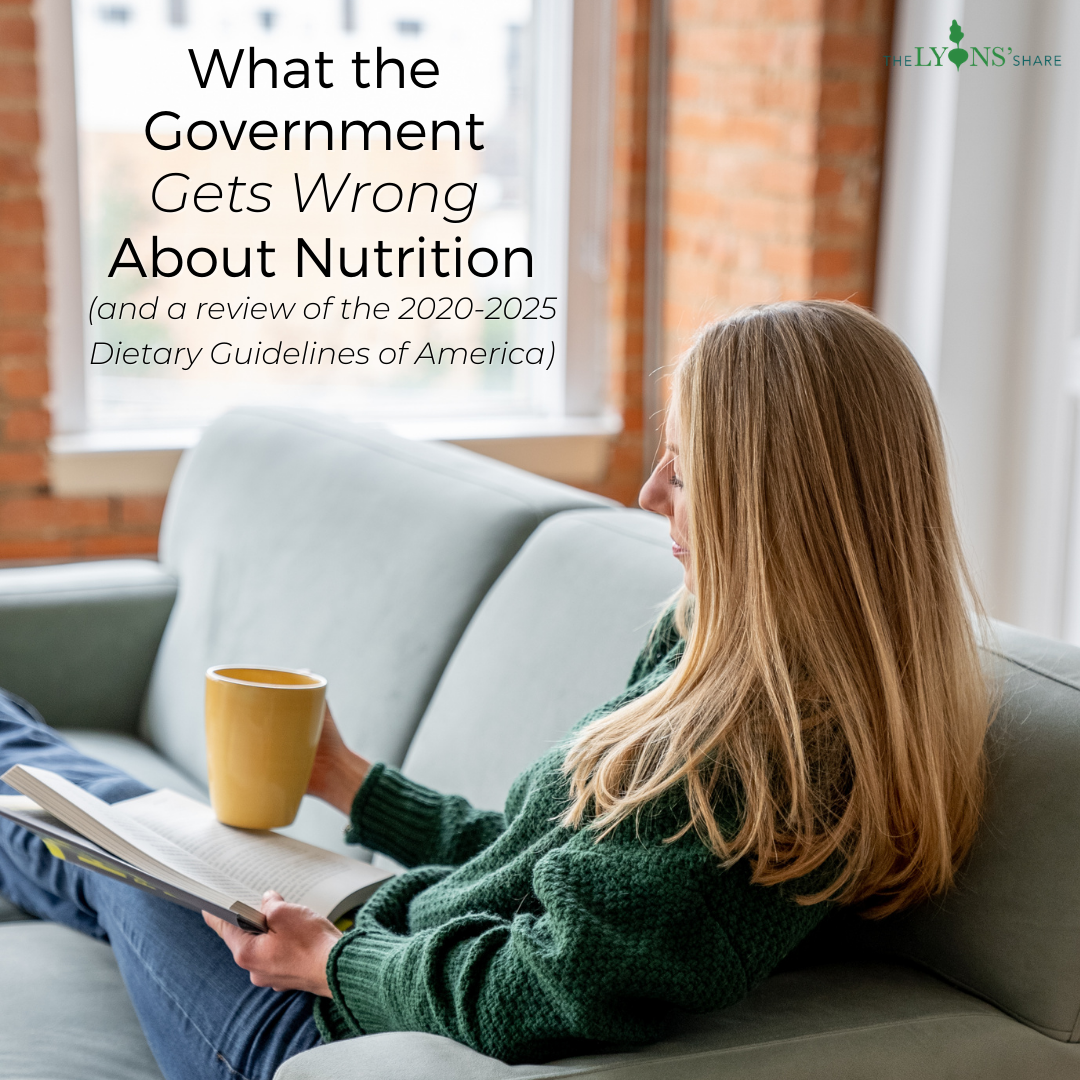The US government spends a lot of money on nutrition. Between the FDA (Food & Drug Administration), the USDA (United States Department of Agriculture), and the HHS (US Department of Health & Human Services), it seems we have an abundance of governmental bodies providing insight and guidance into nutrition. What a nice idea to assume that in this country (which I love and am grateful for in so many ways), we could have instant access to all the cutting-edge nutrition science and have clear, straightforward recommendations on what to eat to make us healthy. Doesn’t that sound nice?
Sadly, it doesn’t pan out that way. The information cascaded to the general public is often either too long, too unclear, or too unpublicized to make an impact on the average American’s consumption patterns, and the output we do receive is often enormously biased.

So, even if we want to read through all 164 pages, can we assume we’d be healthy if we follow the USDA and HHS’ Dietary Guidelines? In short, not really. The Dietary Guidelines of America are supposed to provide us advice on how to eat for best health … but they don’t. Instead, they promote platitudes, like this one, which is one of its 4 overarching principles: “Follow a healthy dietary pattern at every life stage.” This sounds nice … but the corresponding guidance on what a healthy dietary pattern is is both confusing and biased.
Why we can’t trust government nutrition advice
It doesn’t serve anyone to make this a diatribe against the government, but I want us all to go into a review of the latest Dietary Guidelines with a healthy dose of skepticism. Why wouldn’t we assume that the government is acting in our best interest?
First, the influence of lobbyists and the food manufacturing industry in general is enormous. The Dietary Guidelines committee this year included the Current Medical Director of Nestle’s OPTIFAST program, a former member of the Scientific Advisory Board of ConAgra, the President of the Danone Institute (of Dannon yogurt), and a former Advisory Board member of Monsanto, to name a few. In addition, 4 of the 6 members of the “birth-to-24” committee had ties to infant formula companies.
To say they were unbiased is nearly impossible. In 2014-15, right before the 2015 Dietary Guidelines were released, Coca Cola and PepsiCo spent $23.8 million lobbying about soft drinks in the guidelines. This is just one segment – imagine the money pouring in from all aspects of the food industry!

Sadly, even agencies like the FDA, which we think helps keep harmful products out of our food supply and off our shelves, is influenced by lobby money, not by our health. Even if they were acting purely out of the interest of our health, they don’t have the manpower to enforce that every product adheres to the guidelines it sets. For example, in 2015, Kellogg’s promised to take out 7 food additives and dyes in their cereals with documented ties to hyperactivity, asthma, migraines, learning disruptions, and even cancer, by 2018. In fact, Kellogg’s sells many of these same products (for example, Froot Loops and Apple Jacks) in European countries without the food dyes but with more healthful food colorings. However, as of 2021, the dyes are still in the cereals, and the FDA or any other agency is not stepping in.
It’s not that they’re intentionally setting out to kill us, of course, but the food manufacturers want you to like their product (and buy more) more than they want to protect your long-term health! And they’re often willing to be sneaky to do that. For example, people are starting to understand the detriment of MSG, but there are dozens of different names for it permitted on food labels, including hydrolyzed yeast protein, which kind of sounds like nutritional yeast and has “protein” in it, so you might assume it was healthy (it’s not).
Recent Dietary Guidelines for Americans (DGA) changes
Conflicts of interest aside, let’s review the actual guidelines. The HHS and USDA release a set of guidelines every 5 years, and have since 1980. You can download the 2020-2025 guide here, but in the interest of saving you 164 pages, let me cover a few highlights.
First, the great things. I love that there is a new emphasis on nutrition for pregnancy, the lactation period, and infancy. The guidelines have interesting recommendations that I mostly agree with, such as that babies should eat peanut products (under appropriate supervision) at an early age to prevent the allergies that we thought were once caused by early exposure.
I love that the tone of the guidelines attempts to shift the mentality from “taking away bad foods” to “including more nutrient-dense foods.” The focus is on the overall healthy dietary pattern, not just ONE food or food group in isolation that is “bad.” In my coaching, I’m all about focusing on adding in healthful foods, rather than feeling deprived and restricting from the less-healthful ones. There is a “call to action” in the DGA introduction that says, “Make Every Bite Count with the Dietary Guidelines.” This means that we should focus on nutrient-dense foods rather than empty-calorie foods, which is awesome! But this is only a single sentence in the 164-page document, and there is little further information about how to actually implement this.

Let’s dissect the four key recommendations of the DGA:
- “Limiting added sugars to less than 10% of calories per day for ages 2 and older and to avoid added sugars for infants and toddlers”I’m really glad there’s a recommended limit on added sugar! But 200 calories a day (10% of 2000 calorie average) is 13 TEASPOONS of sugar, which is a ton. And the average American currently eats 43 teaspoons of sugar, because it’s in EVERYTHING. Clearly just telling us to stay away isn’t working – we need deeper change, education, and help in taking it out of food supply.
- “Limiting saturated fat to less than 10% of calories per day starting at age 2”This is outdated information! The healthfulness of saturated fat completely depends on source, and in fact, we’re learning that some saturated fat is actually health-promoting, not detrimental. The significant amount of research on saturated fats done in the past 10 years, which concluded no adverse effect on heart disease mortality, was widely ignored, despite a group of scientists trying to protest this.
- “Limiting sodium intake to less than 2,300mg per day (or even less if younger than 14)”Again, I disagree with this one! High quality sea salt, for example, is fine in moderation, and I personally, as a very active healthy individual, consume far more than 2,300mg per day. This is another post for another day, but I encourage you to check out The Salt Fix for more.
- Limiting alcoholic beverages (if consumed) to 2 drinks or less a day for men and 1 drink or less a day for women.This is great! Fully agree here!
So overall, I’m with them on 2 of 4 guidelines, which isn’t a great hit rate. But what I find even more important is what’s missing! What about vegetables? What about protein? Healthy fat? What should we eat amidst all of this stuff we should restrict?

The MyPlate model promoted by the government does show ½ plate full of vegetables & fruits, which I fully agree with, but also recommends having 6 servings / day of grains, with up to 3 of them refined grains like pastas, breads, and cookies … all when we KNOW refined grains contribute to diabetes and heart disease. The MyPlate also still pushes milk, when we know 70% of Americans experience inflammation resulting from dairy, and we can get even better calcium from leafy greens.
So, how should I eat?
The shortest answer I can give is to focus on whole foods. Eat an abundance of leafy green vegetables, plenty of other non-starchy vegetables, and some starchy vegetables and fruit according to your activity level, goals, and blood sugar stability. Eat protein at every meal, focusing on high-quality meats when you choose meat, and complement your meals with a serving or two of healthy fat (like avocados, olives, olive oil, nuts, seeds, and coconut) to ensure that you stay full and provide your body with the stable fuel it needs.
When you do stray from whole foods (because let’s face it, we all do on occasion!), look at the INGREDIENTS first. Be sure there’s no added sugar, and look for whole food ingredients that you recognize, rather than processed, chemical-sounding ingredients. The ingredients are far more important for your health than the number of calories or anything else in the nutrition panel. Include space – non-judgmentally – for things you love a few times per week, and enjoy them mindfully. Don’t forget that this is all complimented by plenty of sleep, moderate activity, hydrating adequately, and managing stress and self-talk consistently.
There … if I can put it into 2 paragraphs, why can’t they put it in 164 pages?

A note on privilege
First, the DGA have been widely criticized for ignoring the 60% of the American population who has one or more diet-related chronic diseases (like heart disease, obesity, and diabetes). The DGA committee did not review a single study on weight loss, despite it being a problem that plagues so many. I agree with this criticism and wish the DGA were more applicable to the majority of people, and the majority of people, sadly, have a chronic disease.
Second, I know I am in a very privileged position to be choosing foods for their health value. I appreciate this privilege immensely, and I want it to be the privilege of every human. I believe that in educating people, we can shift consumer demand towards healthier foods, which will ultimately make food manufacturers produce more of these healthier foods and drive down prices, which will benefit people at all income levels. If there is no sugary cereal, then no one eats sugary cereal … and oatmeal is donated and served at food pantries, etc. instead. YES, I realize this is an incredibly complex issue that I have overly simplified here. But I believe that the way I personally do my part is education, and that is what I am trying to do here. I do not ignore my privilege.
Now it’s your turn … Do you use the USDA Dietary Guidelines for Americans? What popular health information have you been given that you suspect is actually wrong?


I have recently decided to adopt a whole food plant based diet eliminating meat, dairy, sugar and refined grains. Some say to eliminate oils (even healthier ones) and limit nuts and avocados if you are trying to lose weight. My main goal is disease prevention and longevity, but I do need to lose 30lbs.
I wish you the best of luck, Tonya! I hope you find what makes you feel best.